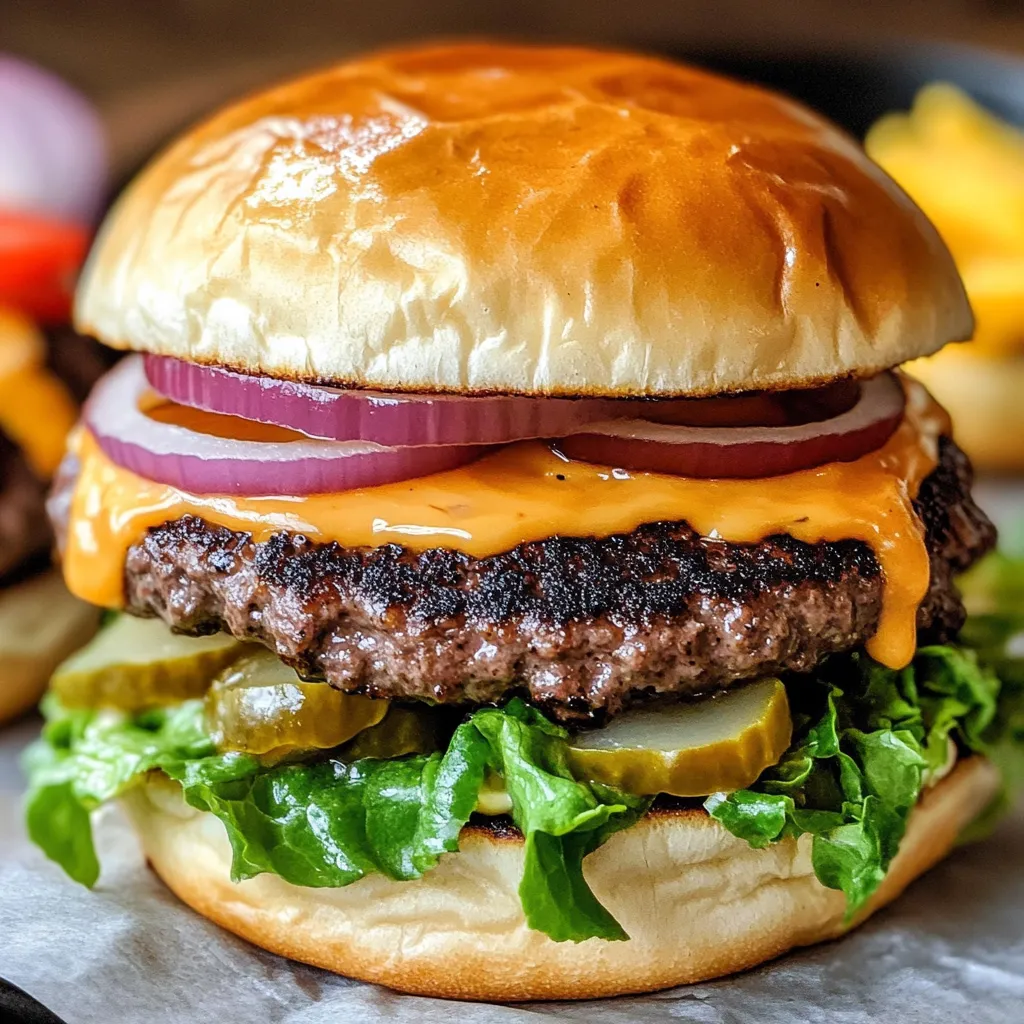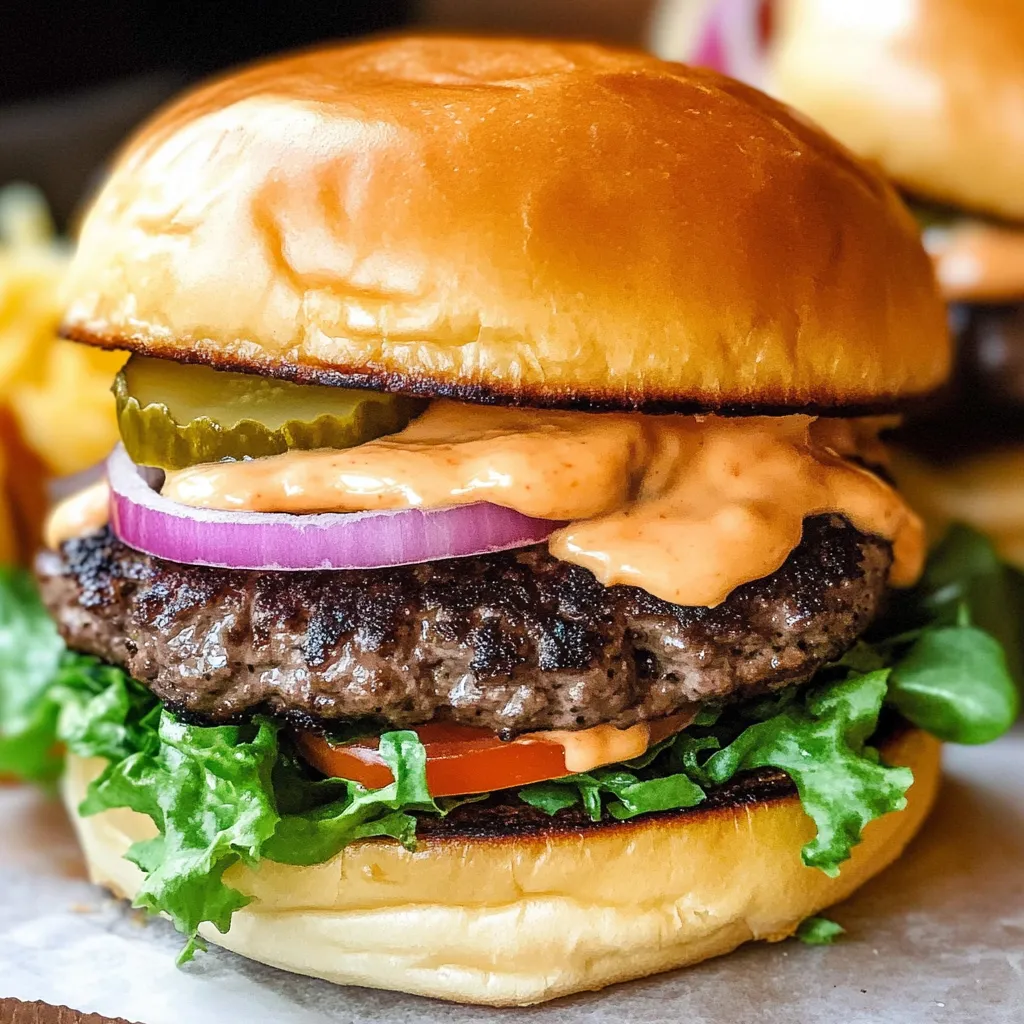 Pin it
Pin it
This restaurant-quality smash burger recipe delivers the perfect combination of crispy, caramelized edges and juicy centers that makes every bite incredibly satisfying and flavorful. The technique of smashing seasoned ground beef balls in a screaming hot cast iron skillet creates those coveted crispy edges while keeping the interior tender and moist. With melty American cheese, toasted buttered buns, and a simple but addictive burger sauce, these smash burgers rival anything you'd get at your favorite burger joint but come together in just 10 minutes.
I discovered smash burgers when I was craving that perfect burger shop experience but didn't want to go out or pay restaurant prices. The first time I made these, I couldn't believe how much flavor and texture you could get from such a simple technique. The key is that screaming hot pan and the confidence to really smash those patties down - it felt wrong at first, but the results were incredible. Now these are our go-to burgers for quick family dinners, and my kids actually prefer them to any restaurant version we've tried. The combination of that crispy crust and melty cheese is absolutely addictive.
Essential Ingredients and Selection Tips:
- Ground beef with 80-85% lean ratio: The higher fat content is crucial for creating the caramelized crust and keeping the meat juicy
- American cheese slices: While it might seem basic, processed American cheese melts perfectly and provides that classic burger shop taste
- Fresh burger buns: Choose soft buns that will toast well; potato buns or brioche work beautifully
- Cast iron skillet: Essential for achieving and maintaining the high heat needed for proper caramelization
- Quality toppings: Fresh lettuce, ripe tomatoes, crisp pickles, and onions make all the difference
- Simple sauce ingredients: Mayonnaise, ketchup, sweet relish, and paprika create the perfect burger sauce
Step-by-Step Instructions:
- Prepare the signature burger sauce:
- In a small bowl, whisk together mayonnaise, ketchup, sweet relish, and a pinch of paprika until completely smooth and well combined. The sauce should be creamy with small pieces of relish throughout, providing both flavor and texture. Cover and refrigerate while you prepare the burgers - this brief chilling time allows the flavors to meld together beautifully.
- Form meat into proper portions:
- Divide your ground beef into 4-ounce portions, which is the ideal size for smash burgers. Very gently form each portion into a loose ball, being careful not to compress the meat too much as this would make the burgers dense. The balls should just hold together and look somewhat rough rather than perfectly smooth. This loose formation is crucial for achieving the right texture after smashing.
- Season and chill the meat:
- Sprinkle the top of each meat ball generously with salt and freshly cracked black pepper. Place the seasoned meat balls in the refrigerator or freezer for 10-15 minutes while your pan heats up. This chilling step helps the meat hold together better during the smashing process and creates better contrast between the hot pan and cold meat for optimal caramelization.
- Heat pan to optimal temperature:
- Place your cast iron skillet over medium-high heat and let it get screaming hot until it's smoking. This usually takes 3-5 minutes depending on your stove. Lightly oil the pan with a high-heat oil like vegetable or canola oil. The pan must be extremely hot for proper caramelization - this is the most critical step for smash burger success.
- Execute the perfect smash technique:
- Working with one meat ball at a time, place it seasoned-side down in the hot pan and immediately smash it down using a large spatula and mallet, or a burger press if you have one. Press firmly and decisively to flatten the patty to about 1/4-inch thickness. You want maximum contact with the hot pan surface to create that coveted caramelized crust. Don't be gentle - confidence is key here.
- Achieve optimal caramelization:
- Cook the first side for about 60-90 seconds without moving or checking until you see a deep brown, caramelized crust forming around the edges. While it cooks, season the top surface with additional salt and pepper. The exact timing depends on your pan and heat level, but you'll know it's ready when you can smell that incredible caramelization happening.
- Flip with precision:
- Using a large, thin spatula, carefully scrape under the entire patty to ensure you capture every bit of that precious caramelized crust. Flip the burger in one confident motion, making sure not to lose any of those crispy, flavorful bits. If desired, immediately place a slice of cheese on top of the cooked side so it begins melting while the second side finishes cooking.
- Finish cooking and toast buns:
- Cook the second side for 45-60 seconds until the burger is cooked through but still juicy. Transfer to a plate and cover with foil to keep warm. Add a pat of butter to the hot pan, and once melted, place burger buns cut-side down to toast for just 15-30 seconds until golden and fragrant. Watch carefully as they toast very quickly.
 Pin it
Pin it
The technique I'm most excited about in this recipe is definitely the smashing method itself. When I first heard about smash burgers, I thought it sounded crazy to literally smash perfectly good ground beef, but the results are absolutely incredible. That moment when you press the cold, seasoned meat into the screaming hot pan and hear that aggressive sizzling is when the magic happens. The high heat combined with maximum surface contact creates this amazing caramelized crust that's packed with flavor while the interior stays juicy and tender. It's completely different from regular grilled burgers and shows how technique can transform simple ingredients into something extraordinary.
Heat Management and Caramelization Mastery
The success of smash burgers depends entirely on achieving and maintaining extremely high heat throughout the cooking process. Cast iron is ideal because it retains heat well and creates even heating across the entire surface. The smoking point indicates the pan is ready - anything less won't create proper caramelization. Understanding the Maillard reaction that creates those complex, savory flavors helps explain why this technique works so effectively for creating maximum flavor in minimal time.
Meat Selection and Preparation Principles
Using ground beef with higher fat content isn't just about flavor - it's essential for the physics of smash burger cooking. The fat renders quickly in the hot pan, creating the medium for caramelization while keeping the meat moist. Leaner beef would result in dry, tough burgers because there isn't enough fat to protect the proteins during the aggressive cooking process. The loose ball formation allows for maximum spreading and surface contact during smashing.
Timing and Technique Coordination
Smash burgers cook incredibly quickly, so having everything prepared and ready is crucial for success. The sauce, toppings, and buns should all be prepped before you start cooking so you can focus entirely on the critical timing of the smashing and flipping process. Understanding the visual and auditory cues that indicate readiness prevents overcooking while ensuring food safety.
Cheese Selection and Melting Optimization
While American cheese might seem like a basic choice, it's actually optimal for smash burgers because it melts evenly and quickly, creating that classic burger shop experience. The processed nature that some people avoid in other contexts is actually beneficial here because it creates smooth, even melting without separation. Adding the cheese immediately after flipping gives it just enough time to melt perfectly without overcooking the burger.
Assembly and Presentation Excellence
The order and timing of assembly affects both flavor and structural integrity of the finished burger. Toasting the buns in the residual heat and butter adds flavor while creating a slight barrier that prevents the bun from getting soggy. The sauce application and topping arrangement can make the difference between a messy sandwich and a perfectly balanced burger that holds together well.
Equipment Optimization and Alternatives
While cast iron is ideal, understanding how to adapt the technique to other equipment ensures success regardless of your kitchen setup. The key principles of high heat and proper smashing can be achieved with various tools, though the results may vary slightly. Recognizing how different pans and heat sources affect timing helps you adjust the technique for consistent results.
These smash burgers have completely changed how I think about making burgers at home because they prove that technique can be more important than expensive ingredients or equipment. There's something so satisfying about the aggressive sizzle when the meat hits the hot pan and knowing that in just a few minutes you'll have something that tastes better than most restaurant burgers. Every time I make them, I'm reminded that some of the best cooking techniques are the ones that seem almost too simple or aggressive to work, but actually create the most incredible results. They've become our family's favorite quick dinner because they deliver maximum flavor and satisfaction in minimal time.
Frequently Asked Questions
- → What makes a smash burger different from regular burgers?
- Smash burgers are pressed flat on a hot griddle, creating a crispy caramelized crust while keeping the inside juicy.
- → What type of ground beef works best for smash burgers?
- Use 80-85% lean ground beef. The fat content helps create flavor and keeps the burger moist when smashed flat.
- → Do I need a special burger press?
- No, you can use a large spatula and press down with a mallet. The key is applying firm, steady pressure to flatten the meat.
- → How long should I cook each side?
- Cook for about 1 minute on the first side until a crust forms, then flip and cook for 45 seconds on the second side.
- → Can I make the burger sauce ahead of time?
- Yes! The sauce can be made up to 5 days in advance and stored in the refrigerator. The flavors actually improve over time.
- → What's the best pan to use for smash burgers?
- A cast iron skillet or flat griddle works best. These retain heat well and create the perfect searing surface for the crust.
